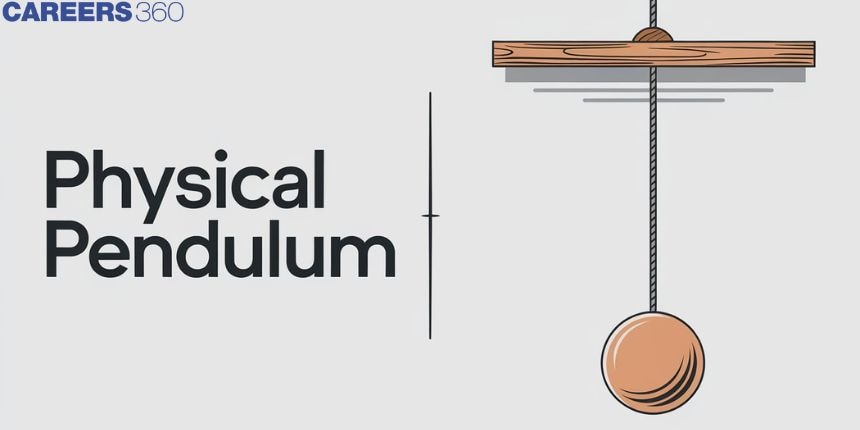Physical Pendulum
The physical pendulum, a fascinating concept in classical mechanics, extends the simple idea of a swinging mass to more complex, real-world objects. Unlike an idealized simple pendulum, where the mass is concentrated at a single point, a physical pendulum takes into account the distribution of mass and the shape of the object, leading to more intricate oscillatory behaviour. Earth itself can be considered a gigantic physical pendulum, especially when we study its precession—a slow, wobbling motion caused by gravitational forces from the Sun and Moon. This natural phenomenon impacts the Earth's orientation and, over time, influences climate patterns and seasons. In our everyday lives, understanding the principles of a physical pendulum helps in designing stable structures, accurate timekeeping devices, and even in the functioning of playground swings.
This Story also Contains
- What is a Physical Pendulum?
- Solved Examples Based on Physical Pendulum
- Summary

What is a Physical Pendulum?
A physical pendulum, also known as a compound pendulum, is a rigid body that is suspended from a fixed point and is free to oscillate back and forth under the influence of gravity. Unlike a simple pendulum, which assumes the mass is concentrated at a single point (like a small bob on a string), a physical pendulum considers the actual distribution of mass throughout the entire object. Any rigid body suspended from fixed support and can oscillate about that support then it is called a physical pendulum. e.g. A circular ring suspended on a nail in a wall etc.

The body is in equilibrium, as shown in the above fig-1 and it is pivoted about point O.
Now the body is displaced through a small angle $\theta$ as shown in the fig-2.
Let the distance between the point of suspension and the centre of mass of the body$=O C=l$
Then torque on the body about O is given by $\tau=m g l \sin \theta$...(1)
Now if I=moment of inertia of the body about O , Then $\tau=I \alpha \ldots$ (2)
From the equation (1) and (2) we get
$
\tau=I \alpha=I \frac{d \theta^2}{d t}=-m g l \sin \theta
$
Since $\theta$ is very small so $I \frac{d \theta^2}{d t}=-m g l \theta$
Comparing with the equation $\frac{d \theta^2}{d t}=-\omega^2 \theta$ we get
$
\omega=\sqrt{\frac{m g l}{I}} \Rightarrow T=2 \pi \sqrt{\frac{I}{m g l}}
$
Note-
Time peried, $T=2 \pi \sqrt{\frac{I}{m g l}} ; \quad I=I_{\mathrm{CM}}+m l^2$
Where $I_{C M}$ is a moment of inertia relative to the axis which passes from the centre of mass and parallel to the axis of oscillation?$
T=2 \pi \sqrt{\frac{I_{\mathrm{CM}}+\mathrm{m} l^2}{m \mathrm{~g} l}}, \text { where } \mathrm{I}_{\mathrm{CM}}=\mathrm{mk}^2
$
k is the gyration radius (about an axis passing from the centre of mass)
$
\begin{aligned}
T & =2 \pi \sqrt{\frac{m k^2+m l^2}{m g l}} \\
& =2 \pi \sqrt{\frac{k^2+l^2}{g l}}=2 \pi \sqrt{\frac{l_{\mathrm{eq}}}{g}} \\
L_{\text {eg }} & =\frac{k^2}{l}+l=\text { cquivalent length of simple pendulum }
\end{aligned}
$
So the graph of the Time period (T) Vs length of a simple pendulum ($l$) is shown below

$\begin{aligned} & T \text { is minimum when } l=k \\ \Rightarrow & T_{\min }=2 \pi \sqrt{\frac{2 k}{g}}\end{aligned}$
Recommended Topic Video
Solved Examples Based on Physical Pendulum
Example 1: What is the effect on the time period of a simple pendulum if the mass of the bob is doubled
1) Halved
2) Doubled
3) Becomes eight times
4) No effect
Solution:
$T=2 \pi \sqrt{\frac{l}{g}} \Rightarrow T \alpha \sqrt{\frac{l}{g}}$,
So, it doesn't depend upon mass.
Hence, the answer is the option (4).
Example 2: A rod of length 2m is suspended through an end and is set into oscillations with small Amplitudes under gravity. The period (in seconds) of the oscillation is :
1) 2.4
2) 1.8
3) 2
4) 1.6
Solution:
$\begin{aligned} T & =2 \pi \sqrt{\frac{2 l}{3 g}} \quad \text { [Physical Pendulum] } \\ \Rightarrow T & =2 \pi \sqrt{\frac{2 \times 2}{3 \times 9.8}}=2.4 \mathrm{~s}\end{aligned}$
Hence, the answer is the option (1).
Example 3: A simple pendulum is executing simple harmonic motion with a period T. If the length of the pendulum is increased by 21%, the percentage increase in the period of the pendulum of increased length is (answer in %) :
1) 10
2) 21
3) 30
4) 50
Solution:
If the initial length $l_1=100$ then $l_2=121$
By using
$
T=2 \pi \sqrt{\frac{l}{g}} \Rightarrow \frac{T_1}{T_2}=\sqrt{\frac{l_1}{l_2}}
$
Hence, $\frac{T}{T_2}$
$
\begin{aligned}
\frac{T_1}{T_2} & =\sqrt{\frac{100}{121}} \Rightarrow T_2=1.1 T_1 \\
& =\frac{T_2-T_1}{T_1} \times 100=10 \%
\end{aligned}
$
Hence, the answer is the option (1).
Example 4: A thin uniform rod of length is pivoted at its upper end. It is free to swing in the vertical plane. Its period for oscillation of small amplitude is :
1) $2 \pi \sqrt{\frac{l}{g}}$
2) $2 \pi \sqrt{\frac{2 l}{3 g}}$
3) $2 \pi \sqrt{\frac{3 l}{2 g}}$
4) $2 \pi \sqrt{\frac{l}{3 g}}$
Solution:
$T=2 \pi \sqrt{\frac{I}{M g \frac{l}{2}}}=2 \pi \sqrt{\frac{m^{\frac{l^2}{3}}}{m g^{\frac{l}{2}}}} \Rightarrow T=2 \pi \sqrt{\frac{2 l}{3 g}}$
Hence, the answer is the option (2).
Example 5: A disc of radius R and mass M is pivoted at the rim and set for small oscillations about an axis perpendicular to the plane of the disc. If a simple pendulum has the same time period as of disc, the length of the pendulum should be
1) $\frac{5}{4} R$
2) $\frac{2}{3} R$
3) $\frac{3}{4} R$
4) $\frac{3}{2} R$
Solution:
$T=2 \pi \sqrt{\frac{I}{M g L}}=2 \pi \sqrt{\frac{l}{g}} \Rightarrow l=\frac{I}{M L}=\frac{\frac{3}{2} M R^2}{M R}=\frac{3}{2} R$
Hence, the answer is the option (4).
Summary
A physical pendulum is a solid body that swings around a fixed point due to gravity. The entity is dissimilar to a simple pendulum due to the consideration of mass location and moment of inertia. For a physical pendulum, its certain moment of inertia and the distance from the centre of mass to the pivot affect the time it takes to complete one cycle.